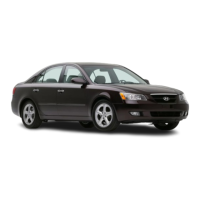Do you have a question about the Hyundai BC3 and is the answer not in the manual?
Information on using leaded gasoline if equipped, and gasoline containing alcohol and methanol.
Details on using fuel additives and their potential impact on the vehicle.
Recommendations and cautions regarding fuels containing MTBE.
Warnings about modifying the vehicle and using unauthorized electronic devices.
Precautions for the first 1,000 km (600 miles) to ensure optimal performance and life.
Diagrams and descriptions of the vehicle's exterior components.
Diagrams and descriptions of the vehicle's interior controls and features.
Detailed diagrams and explanations of the instrument panel components.
Identification of key components within the engine compartment.
Specifications for the vehicle's external dimensions.
Technical details about the vehicle's engine.
List of light bulbs used in the vehicle and their wattages.
Information on tire sizes, inflation pressure, and wheel lug nut torque.
Specifications for refrigerant and compressor lubricant.
Details on tire load capacity and speed symbols.
Information on the gross vehicle weight for different models.
Specifications for the vehicle's luggage volume.
List of recommended lubricants and their capacities for various vehicle systems.
Chart for selecting engine oil viscosity based on temperature.
Location and purpose of the VIN and vehicle certification label.
Information on tire specifications and recommended pressures.
Location of the engine number stamped on the engine block.
Key safety precautions for drivers and passengers, including seat belt use and air bag safety.
Details on adjusting front and rear seats, headrests, and seat warmers.
Instructions on proper seat belt usage, safety precautions, and care.
Guidelines for selecting and installing child restraint systems.
Information on the SRS, locations of air bags, and safety precautions.
How to adjust the brightness of the instrument panel illumination.
Explanation of the speedometer, tachometer, engine coolant temperature, and fuel gauges.
Information on manual and automatic transmission shift indicators.
Explanation of various warning and indicator lights on the instrument cluster.
Explanation of various warning messages displayed on the LCD screen.
Description of available modes on the LCD display like Trip Computer and Driving Assist.
Instructions for using the remote key and smart key for locking and unlocking.
How to operate door locks from outside and inside the vehicle.
Information on electric power steering (EPS), tilt/telescope steering, and horn operation.
Adjusting inside and outside rearview mirrors, including day/night and electric chromic mirrors.
Operation of power windows, including auto up/down and reverse features.
Instructions for operating the sunroof, including opening, closing, tilting, and resetting.
Steps for opening and closing the vehicle's hood.
Instructions for opening and closing the tailgate, including safety precautions.
Procedure for opening and closing the fuel filler door and refueling safety.
Operation of exterior lights, including lighting control, fog lamps, and high beam.
Information on interior lighting, including map lamps, door lamps, and room lamps.
Operation and maintenance of windshield and rear window wipers and washers.
Instructions for operating the manual climate control system, including mode selection.
Guide to operating the automatic climate control system for heating and cooling.
Information on USB port, antenna, audio controls, voice recognition, and Bluetooth connectivity.
Instructions for adjusting the vehicle's clock.
Information on the proper use and limitations of coat hooks.
Guidelines for using floor mat anchors to secure floor mats safely.
Instructions on using the luggage net to secure items in the cargo area.
How to use and remove the cargo area cover.
Checks and precautions before entering and starting the vehicle.
Explanation of key ignition switch positions and related precautions.
Detailed steps for starting the engine with manual and automatic transmissions.
Operation of the manual transmission, including shift patterns and precautions.
Proper clutch pedal operation, downshifting, and maintenance precautions.
Essential tips for safe driving, including cornering, braking, and slippery conditions.
Explanation of iMT system operation, including shift patterns and cautions.
Operation of the automatic transmission, including transmission ranges and warnings.
Details on the operation of the dual clutch transmission and its characteristics.
Information on power brakes, disc brakes, rear drum brakes, parking brake, ABS, ESC, VSM, HAC, ESS, MCB.
Explanation of the ISG system, its conditions of operation, and how to activate/deactivate it.
How the SSC system helps reduce fuel consumption by stopping the engine.
Explanation of Drive Mode settings (ECO, COMFORT, SPORT) and their impact on driving dynamics.
Precautions and advice for driving in hazardous conditions like snow, mud, or sand.
Important tips and safety rules for towing a trailer, including weight limits and handling.
Explanation of weight ratings like GVW, GVWR, Base Curb Weight, and Cargo Weight.
Basic function, detecting sensors, system settings, and warnings for FCA.
How LKA helps detect lane markings and assists steering to keep the vehicle centered.
How BCW detects and warns about vehicles in the driver's blind spot.
How BCA detects and warns about vehicles in the blind spot and assists braking.
How to set and use the MSLA system to maintain a specific speed.
How ISLA uses road sign and navigation data to inform the driver of speed limits.
How DAW analyzes driving patterns to recommend breaks and alerts when the vehicle departs the lane.
How to set, increase, decrease, temporarily cancel, and turn off Cruise Control.
How NSCC adjusts vehicle speed using navigation data for motorway driving.
How the RVM assists with parking by showing the area behind the vehicle.
How RCCW detects approaching vehicles while reversing and warns the driver.
How RCCA detects vehicles while reversing and assists braking to prevent collisions.
How PDW warns the driver of obstacles detected when moving in reverse.
How Parking Assist helps with parallel and perpendicular parking maneuvers.
Identification of key components in the engine compartment for different engine types.
Owner's responsibility and precautions for performing maintenance and inspections.
Checks to perform when stopping for fuel and general vehicle checks.
Guidance on following Normal or Severe Usage maintenance schedules based on driving conditions.
Detailed explanations for engine oil, drive belts, fuel filter, fuel lines, and hoses.
Inspection and replacement guidelines for vacuum crankcase ventilation hoses.
Recommendation for air cleaner filter replacement by an authorized dealer.
Instructions for installing new spark plugs of the correct heat range.
Checking cooling system components for leaks and damage.
Guidelines for checking and changing engine coolant, including warnings about hot coolant.
Inspection of manual transmission actuator fluid level and handling precautions.
Recommendation for automatic transmission fluid change by an authorized dealer.
Inspection of dual clutch transmission fluid according to the maintenance schedule.
Visual inspection of brake hoses and lines for damage and leakage.
How to check brake/clutch fluid level and warnings about potential leaks.
How to check the parking brake stroke and ensure it holds the vehicle securely.
Inspection of rear brake drums and linings for wear and damage.
Checking brake pads for wear and discs for run out and wear.
Tire care, recommended inflation pressures, and alignment/balance.
Information on fuse types, replacement procedures, and electrical system protection.
Steps for replacing fuses in the instrument panel fuse panel.
Procedure for replacing fuses in the engine compartment fuse panel.
Procedure for removing and replacing the multi fuse.
Location and description of fuses and relays in the driver's side fuse panel.
General information and precautions for replacing light bulbs, including traffic changes for Europe.
Explanation of the emission control systems and precautions for their proper function.
Guidelines for exterior care, including washing, waxing, and protection from corrosion.
How to use the hazard warning flasher to alert other drivers.
What to do if the engine stalls or you have a flat tire while driving.
Troubleshooting steps if the engine doesn't turn over or turns over slowly.
Precautions and procedure for safely jump starting a vehicle.
Actions to take if the engine overheats, including checking coolant and safety precautions.
How the TPMS works, reset procedure, and indicators for low pressure or malfunction.
Instructions for changing a tire, including using the jack and tools.
Guidelines and precautions for using a compact spare tire.
Information on towing services, removable towing hooks, and emergency towing procedures.
List of emergency commodities and their uses, including fire extinguisher and first aid kit.
Explanation of the eCall system, its operation, and data processing.
Information on using leaded gasoline if equipped, and gasoline containing alcohol and methanol.
Details on using fuel additives and their potential impact on the vehicle.
Recommendations and cautions regarding fuels containing MTBE.
Warnings about modifying the vehicle and using unauthorized electronic devices.
Precautions for the first 1,000 km (600 miles) to ensure optimal performance and life.
Diagrams and descriptions of the vehicle's exterior components.
Diagrams and descriptions of the vehicle's interior controls and features.
Detailed diagrams and explanations of the instrument panel components.
Identification of key components within the engine compartment.
Specifications for the vehicle's external dimensions.
Technical details about the vehicle's engine.
List of light bulbs used in the vehicle and their wattages.
Information on tire sizes, inflation pressure, and wheel lug nut torque.
Specifications for refrigerant and compressor lubricant.
Details on tire load capacity and speed symbols.
Information on the gross vehicle weight for different models.
Specifications for the vehicle's luggage volume.
List of recommended lubricants and their capacities for various vehicle systems.
Chart for selecting engine oil viscosity based on temperature.
Location and purpose of the VIN and vehicle certification label.
Information on tire specifications and recommended pressures.
Location of the engine number stamped on the engine block.
Key safety precautions for drivers and passengers, including seat belt use and air bag safety.
Details on adjusting front and rear seats, headrests, and seat warmers.
Instructions on proper seat belt usage, safety precautions, and care.
Guidelines for selecting and installing child restraint systems.
Information on the SRS, locations of air bags, and safety precautions.
How to adjust the brightness of the instrument panel illumination.
Explanation of the speedometer, tachometer, engine coolant temperature, and fuel gauges.
Information on manual and automatic transmission shift indicators.
Explanation of various warning and indicator lights on the instrument cluster.
Explanation of various warning messages displayed on the LCD screen.
Description of available modes on the LCD display like Trip Computer and Driving Assist.
Instructions for using the remote key and smart key for locking and unlocking.
How to operate door locks from outside and inside the vehicle.
Information on electric power steering (EPS), tilt/telescope steering, and horn operation.
Adjusting inside and outside rearview mirrors, including day/night and electric chromic mirrors.
Operation of power windows, including auto up/down and reverse features.
Instructions for operating the sunroof, including opening, closing, tilting, and resetting.
Steps for opening and closing the vehicle's hood.
Instructions for opening and closing the tailgate, including safety precautions.
Procedure for opening and closing the fuel filler door and refueling safety.
Operation of exterior lights, including lighting control, fog lamps, and high beam.
Information on interior lighting, including map lamps, door lamps, and room lamps.
Operation and maintenance of windshield and rear window wipers and washers.
Instructions for operating the manual climate control system, including mode selection.
Guide to operating the automatic climate control system for heating and cooling.
Information on USB port, antenna, audio controls, voice recognition, and Bluetooth connectivity.
Instructions for adjusting the vehicle's clock.
Information on the proper use and limitations of coat hooks.
Guidelines for using floor mat anchors to secure floor mats safely.
Instructions on using the luggage net to secure items in the cargo area.
How to use and remove the cargo area cover.
Checks and precautions before entering and starting the vehicle.
Explanation of key ignition switch positions and related precautions.
Detailed steps for starting the engine with manual and automatic transmissions.
Operation of the manual transmission, including shift patterns and precautions.
Proper clutch pedal operation, downshifting, and maintenance precautions.
Essential tips for safe driving, including cornering, braking, and slippery conditions.
Explanation of iMT system operation, including shift patterns and cautions.
Operation of the automatic transmission, including transmission ranges and warnings.
Details on the operation of the dual clutch transmission and its characteristics.
Information on power brakes, disc brakes, rear drum brakes, parking brake, ABS, ESC, VSM, HAC, ESS, MCB.
Explanation of the ISG system, its conditions of operation, and how to activate/deactivate it.
How the SSC system helps reduce fuel consumption by stopping the engine.
Explanation of Drive Mode settings (ECO, COMFORT, SPORT) and their impact on driving dynamics.
Precautions and advice for driving in hazardous conditions like snow, mud, or sand.
Important tips and safety rules for towing a trailer, including weight limits and handling.
Explanation of weight ratings like GVW, GVWR, Base Curb Weight, and Cargo Weight.
Basic function, detecting sensors, system settings, and warnings for FCA.
How LKA helps detect lane markings and assists steering to keep the vehicle centered.
How BCW detects and warns about vehicles in the driver's blind spot.
How BCA detects and warns about vehicles in the blind spot and assists braking.
How to set and use the MSLA system to maintain a specific speed.
How ISLA uses road sign and navigation data to inform the driver of speed limits.
How DAW analyzes driving patterns to recommend breaks and alerts when the vehicle departs the lane.
How to set, increase, decrease, temporarily cancel, and turn off Cruise Control.
How NSCC adjusts vehicle speed using navigation data for motorway driving.
How the RVM assists with parking by showing the area behind the vehicle.
How RCCW detects approaching vehicles while reversing and warns the driver.
How RCCA detects vehicles while reversing and assists braking to prevent collisions.
How PDW warns the driver of obstacles detected when moving in reverse.
How Parking Assist helps with parallel and perpendicular parking maneuvers.
Identification of key components in the engine compartment for different engine types.
Owner's responsibility and precautions for performing maintenance and inspections.
Checks to perform when stopping for fuel and general vehicle checks.
Guidance on following Normal or Severe Usage maintenance schedules based on driving conditions.
Detailed explanations for engine oil, drive belts, fuel filter, fuel lines, and hoses.
Inspection and replacement guidelines for vacuum crankcase ventilation hoses.
Recommendation for air cleaner filter replacement by an authorized dealer.
Instructions for installing new spark plugs of the correct heat range.
Checking cooling system components for leaks and damage.
Guidelines for checking and changing engine coolant, including warnings about hot coolant.
Inspection of manual transmission actuator fluid level and handling precautions.
Recommendation for automatic transmission fluid change by an authorized dealer.
Inspection of dual clutch transmission fluid according to the maintenance schedule.
Visual inspection of brake hoses and lines for damage and leakage.
How to check brake/clutch fluid level and warnings about potential leaks.
How to check the parking brake stroke and ensure it holds the vehicle securely.
Inspection of rear brake drums and linings for wear and damage.
Checking brake pads for wear and discs for run out and wear.
Tire care, recommended inflation pressures, and alignment/balance.
Information on fuse types, replacement procedures, and electrical system protection.
Steps for replacing fuses in the instrument panel fuse panel.
Procedure for replacing fuses in the engine compartment fuse panel.
Procedure for removing and replacing the multi fuse.
Location and description of fuses and relays in the driver's side fuse panel.
General information and precautions for replacing light bulbs, including traffic changes for Europe.
Explanation of the emission control systems and precautions for their proper function.
Guidelines for exterior care, including washing, waxing, and protection from corrosion.
How to use the hazard warning flasher to alert other drivers.
What to do if the engine stalls or you have a flat tire while driving.
Troubleshooting steps if the engine doesn't turn over or turns over slowly.
Precautions and procedure for safely jump starting a vehicle.
Actions to take if the engine overheats, including checking coolant and safety precautions.
How the TPMS works, reset procedure, and indicators for low pressure or malfunction.
Instructions for changing a tire, including using the jack and tools.
Guidelines and precautions for using a compact spare tire.
Information on towing services, removable towing hooks, and emergency towing procedures.
List of emergency commodities and their uses, including fire extinguisher and first aid kit.
Explanation of the eCall system, its operation, and data processing.
| Brand | Hyundai |
|---|---|
| Model | BC3 |
| Category | Automobile |
| Language | English |












